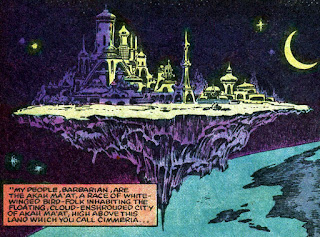"...a suspicious folk, who flourish their knives at a harsh word. At night they strike without provocation."
- The Dirdir, Jack Vance
Arim in the West of Talislanta is described in
The Chronicles as "a grey and windy realm" of "rough and irregular hills." The
Handbook (1987) tells us it's people are: "a dour and moody folk who find no joy in song, dance or revelry. They drink heavily, favoring chakos, a bitter and metallic tasting liquor." They're neither lookers nor snappy dressers, as Tamerlin observes:
They are swarthy of complexion, with long black hair and dark, deep-set eyes. The men tend to be gaunt and wiry, with glaring countenances and hatchet-like features; the women, heavy-set and lacking in charm. The customary mode of dress in this region defies all concept of fashion, and consists primarily of sackcloth garments, animal hide boots, bulky fur vests, and wristbands, knives, and ear-rings made of dull, black iron.
This description is largely ignored in later editions where they tend to present Arimites as well-muscled, relatively attractive folk.
Arimites are mostly miners, but this is usually only mentioned in passing to get to the more interesting stuff: Arimites' fame as skilled knife-fighters and their secret Revenant cult.
The Chronicle describes the Revenants as "members of a secret society who specialize in carrying out acts of vengeance for their clients." Tamerlin reports that they have subspecialties in various "forms of revenge from delivering insults and threats to arson, coercion, muggings and murder-for-hire." Later editions tend to emphasize their roll as assassins, implying that that's all they do.
The deuterocanonical
Cyclopedia Talislanta vol. IV gives information on the structure of Revenant Cult's cells and mentions a mysterious High Revenant that rules them all. Third edition says this leader is an assassin-mage who lives in a mountain top sanctum, which seems unlikely given the preponderance of evidence indicating the Arimites are poor mages. All editions agree that the Revenants are the
de facto rulers of Arim, in that the nominal ruler, the Exarch, refuses to leave the Forbidden City of Ahrazahd out of fear of them. The Exarch, for what it's worth, is not very popular among his people.
The
Cyclopedia holds that Arimites worship or perhaps revere Destiny, or have a few of cults that do. Fourth edition says they are agnostics.
The Arimites have the gloomy environment of Robert E. Howard's
Cimmerians and elements of a number of hill or mountain folk. They've got a thing for knives like the Afghans of pulp tradition with their
Khyber knives, though the Arimites mostly use throwing knives. They're miners, and prone to feuding and substance abuse, traits often associated with Appalachian folk. I say play up that stuff and add a bit from the Khors of Vance's Tshcai--see the quote at the start, and here's another: "they consider garrulity a crime against nature."
The Revenants at times seem to be trying to draw on the Persian Order of Assassins and maybe even the ninja. I'm okay with that, as long as a hillbilly element is played up. I also like the Vancian absurdity of them doing acts of vengeance besides murdering people.
Exarch as the title of Arim's ruler is interesting. Since it's a Byzantine title for a governor of a territory, it suggests to me that the earliest exarchs were perhaps barbarian stoogies of the Phaedran Empire. A "Forbidden City" is an odd detail for hillfolk, but I assume it's more a fortified town and the Exarch is more a chieftain or tribal leader with delusions of grandeur.



















